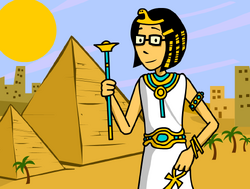| Cleopatra | |||
|---|---|---|---|
| Season | 5 | ||
| Airdate | April 7, 2007
Remake: January 15, 2017 | ||
| Curriculum | Social Studies | ||
Cleopatra is a BrainPOP Social Studies video that aired April 7, 2007.
Summary
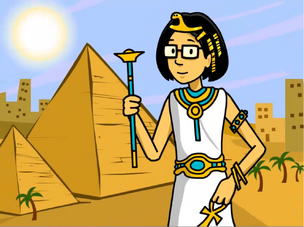
Rita's appearance is changed
The movie starts as Tim and Moby are watching a "bad movie" Tim says about it. Then reads letter about asking about Cleopatra.
At the end, Tim holds a cell phone. Moby beeps. "Just calling Rita...to say hi." Says Tim, blushing.
Plot for Cleopatra
After Cleopatra (Rita) is born, Hellenistic civilization goes into decline.
At age 18, she inherits the family throne, but her 12-year-old brother, who does not get along with her at all, kicks her out of power and becomes Pharaoh.
In Rome, Julius Caesar (Moby) is a General in the Roman army, helping the Roman Empire expand its boundaries, claiming new territories, and winning most of their battles. Upon hearing news about Cleopatra being overthrown, Caesar is dispatched to Egypt to settle the dispute.
However, when Caesar arrives in Egypt, he discovers a rolled-up carpet awaiting him. Caesar unrolls the carpet to discover Cleopatra inside. Cleopatra uses her charm to win Caesar over to her side, and the two conspire to overthrow her brother. When they do, Cleopatra becomes Pharaoh, falls in love with Caesar, and gives birth to a boy, Caesarion; Caesar returns to Rome and becomes dictator.
In 44 B.C., Caesar is brutally assassinated by senators (Crusher and Bruiser) conspiring against him. After Caesar's murder, his position as General of the Roman Army is replaced by Mark Antony (Tim), who takes control of Rome, alongside Caesar's adopted son Octavion (Gary, Jr.).
2 years later, fearing that Rome will overthrow her from her status as Pharaoh, Cleopatra asks Mark Antony for protection. When she arrives in a special boat, Antony - despite being married to Octavion's sister - marries her, and the two of them have 3 children, to whom Antony decides to make rulers of various Roman territories. Back in Rome, Octavion hears the news and declares war on Cleopatra and Antony.
11 years later, they finally fight at the Battle of Actium, which Octavion wins, and Cleopatra and Antony flee into exile.
Finally overthrown from power, Cleopatra allows an asp to fatally bite her. At the same time, any soldiers that remained with Antony abandon him, and he fatally stabs himself in the chest.
With both Antony and Cleopatra dead, Octavion changes his name to Augustus, conquers Egypt, and becomes the first ever Roman Emperor.
Appearance Roles
- Tim as Mark Antony
- Moby as Julius Caesar
- Rita as Cleopatra
- Gary, Jr. as Octavian
- Crusher and Bruiser as Roman assassins
Transcript
Quiz
FYI
Arts And Entertainment
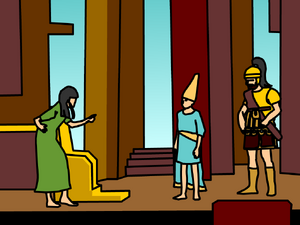
Cleopatra is more than just a historical figure—she’s a famed literary character.
Perhaps the best-known literary work to feature her is William Shakespeare’s play "Antony and Cleopatra", written around 1606. In the play, the character of Enobarbus describes Cleopatra’s almost otherworldly beauty thusly: “Age cannot wither her, nor custom stale / Her infinite variety."
Shakespeare presents Cleopatra as the epitome of sensuality, and she and Antony constantly make public and outrageous declarations of love for one another. Shakespeare’s story was updated by British dramatist John Dryden in his 1678 play, All for Love, which deals with Antony and Cleopatra’s last hours.
A very different Cleopatra appears in George Bernard Shaw’s 1901 play Caesar and Cleopatra. Here, the queen is portrayed as a spoiled, vengeful 16-year-old, instead of a mature love goddess. The focus of the play is political, not romantic—the plot shows how Caesar, the master politician, teaches the immature Cleopatra how to rule her kingdom. Shaw’s knack for witty lines was better than his knowledge of history, as the real Cleopatra was in her early 20s when she met Julius Caesar.
Unsolved Mysteries

In film, TV, and theater, Cleopatra is usually presented as an extraordinarily beautiful woman. Perhaps it's because her story is so full of tragic romance. Her epic love affairs with Julius Caesar and Mark Antony are the subject of countless works of poetry and drama. But how do we know what Cleopatra really looked like?
Well, we don't. Very few images of Cleopatra that were made during her lifetime survive today—just a few sculptures and a handful of coins. Julius Caesar’s adopted son, Octavian, who conquered Egypt and defeated Cleopatra, had most representations of her destroyed after her death.
To make matters more confusing, most of the Egyptian images that did survive were never meant to reflect what she actually looked like. The Egyptian style at the time was idealized, rather than realistic. There are very few surviving sculptures that archeologists think are of Cleopatra—and they all seem to portray a different woman!
Of the coins showing Cleopatra's face, only about 10 survive in good condition. Those coins also show a variety of profiles, further shrouding the real Cleopatra in mystery. One coin shows her with a strong jaw and curved nose. On another featuring both her and Mark Antony's faces, she looks almost like his twin! Historians believe that she commissioned different coins depending on the image she wanted to project.
Coins could function as political propaganda, passing quickly from hand to hand to spread a message. A square jaw and hooked nose made her look like her father, possibly cementing her claim to the throne in a battle with her brother. The joint coin with Antony might have been minted to promote their relationship and political alliance.
Historians have almost no evidence for Cleopatra's physical appearance. But they agree that she was exceptionally intelligent, and a skilled political and military operator. She was an effective leader in a difficult time, and the only woman of her time to reign alone. Under the eye of a Roman empire torn by civil war, she ruled Egypt for 18 years—from the age of 21 until her death. In defeat, she died rather than surrender to her enemy. With her death, the 3,000-year rule of the Egyptian Pharaohs came to an end.
In Depth
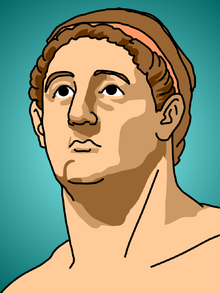
As Tim mentions in the movie, Cleopatra wasn’t Egyptian. But she was Queen of Egypt. So how did that happen? It was because Cleopatra was the last member of the Ptolemaic Dynasty.
Alexander the Great, who hailed from Macedonia in northern Greece, conquered Egypt in 332 B.C.E. When he died nine years later, one of his generals declared himself the new pharaoh of Egypt. This general was named Ptolemy I Soter (pictured). All male heirs to the throne were also named Ptolemy, and most queens and princesses were named either Berenice or Cleopatra (the Cleopatra we know was officially Cleopatra VII).
The royal family and their inner circle were far more Greek than Egyptian. In fact, Cleopatra was the first Ptolemy who spoke the Egyptian language! However, the Ptolemies built huge temples to the Egyptian gods and presented themselves outwardly as the descendants of the pharaohs.
In order to emulate the pharaohs, and also to keep power within the family, Ptolemaic kings married their sisters, with whom they reigned as co-rulers. Cleopatra’s parents, in fact, were brother and sister, and she herself was forced to marry two of her brothers, Ptolemy XIII and Ptolemy XIV.
Did You Know

In the early 1960s, the film studio 20th Century Fox was facing financial difficulties. Several of its most expensive movies had flopped at the box office, and it needed a sure-fire hit that moviegoers would flock to in the millions. They decided that their best bet would be an epic retelling of the story of Cleopatra. Unfortunately, they had no idea exactly how epic their project was going to be.
Filming started in England in 1960, but star Elizabeth Taylor (pictured) became ill with pneumonia and couldn’t work. So the film was shut down for six months while Taylor recovered.
To make matters worse, the cold English weather proved bad for her health, so the studio moved the whole production to Rome. All the footage shot in England, and the sets that were built there were thrown out—it was about $5 million down the toilet.
The price went up from there. Elizabeth Taylor’s wardrobe consisted of 65 separate costumes, one of which was a dress made out of actual gold! And Taylor was paid the then-unheard of salary of $1 million.
All in all, Cleopatra cost $44 million to make—that’s more than $286 million in 2007 dollars! In fact, after almost half a century, it’s still the second-most-expensive movie ever made (the most expensive was a Soviet production of War and Peace that came out later that same decade).
FYI comic
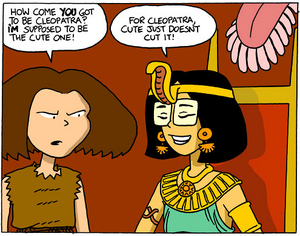
Rita dressed like Cleopatra as her role.
Cassie told Rita about Cassie being Cleopatra because Cassie said that she's supposed to be the cute one, but for Cleopatra, cute doesn't cut it.
Cassie: How come you got to be Cleopatra? I'm supposed to be the cute one!
Rita: For Cleopatra, cute just doesn't cut it!

